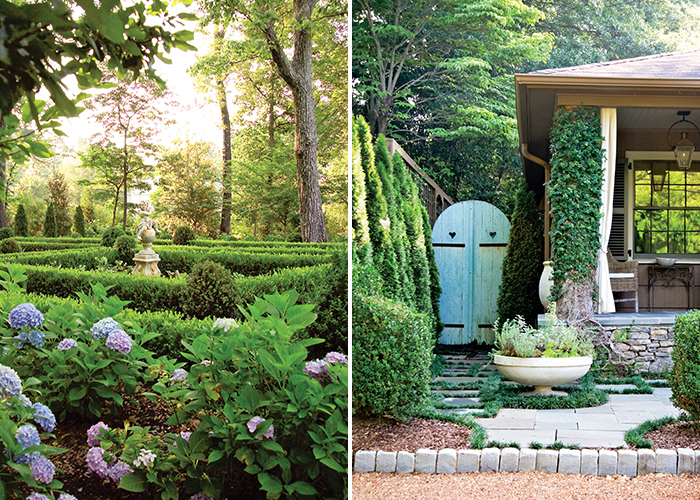Carson McElheney | Atlanta, Georgia
With a love of history and deep connection to both land and architecture, McElheney is a devoted traditionalist who coaxes as much beauty out of a kitchen garden as from a clipped parterre.
 Design influences: George Washington and Thomas Jefferson both loved and respected the natural landscape, and they’ve each made deep impressions on me. Washington was a skilled surveyor who assessed a particular piece of ground and sited buildings on it for the best vantage and value. Jefferson’s meticulous planting and landscaping enhanced his architectural artistry and vice versa. When I was very young, my grandparents took me to visit Mount Vernon and Monticello, and the history drew me in.
Design influences: George Washington and Thomas Jefferson both loved and respected the natural landscape, and they’ve each made deep impressions on me. Washington was a skilled surveyor who assessed a particular piece of ground and sited buildings on it for the best vantage and value. Jefferson’s meticulous planting and landscaping enhanced his architectural artistry and vice versa. When I was very young, my grandparents took me to visit Mount Vernon and Monticello, and the history drew me in.
Advice to new clients: Begin with a good foundation of plantings. Establish a plant palette of five to nine specimens to learn how they grow and develop through each season. Some classics I recommend are American boxwood; oakleaf, ‘Annabelle,’ or ‘Endless Summer’ hydrangeas (they’re all easy); ‘August Beauty’ gardenia; ‘Fifth Avenue’ camellia; pachysandra; autumn fern; bridal wreath spirea; ‘Cloud 9’ dogwood; ‘Mariesii’ viburnum; and overcup oak.
Looking to the past: Finding a balance between historical accuracy and contemporary lifestyle is important. I like our work to be as authentic as possible, but within reason. We live a very different lifestyle today.
Passing on traditions: My family spends the majority of our weekends at our farm. My children—Mary Brooks is 5 and Carson is 2—love being there and in the garden. From the boxwood potager to the farm fields where I have 70 acres of row crops, including corn, sunflower, milo, soybean, and winter wheat, there’s plenty of evidence for them to see what you can grow from just one tiny seed.
Dream project: A plantation or estate project similar to Mulberry Plantation in coastal South Carolina. It has every element: refined gardens, boxwood parterres, kitchen herb gardens, orangeries, and even those majestic live oaks.
Favorite garden quote: “No occupation is so delightful to me as the culture of the earth, and no culture comparable to that of the garden.” –Thomas Jefferson, 1811

An avid bird hunter and staunch naturalist, landscape architect Carson McElheney’s landscapes are often inspired by the collaboration of Gertrude Jekyll and Sir Edmund Lutyens, whose work resulted in spaces that “marry plantings and exquisite hardscape design,” he says. | Photography by Emily Followill
Jeffrey Carbo | Alexandria and Baton Rouge, Louisiana
This landscape architect brings a modernist sensibility to gardens in Louisiana and beyond. Sustainability is at the heart of his work, and Carbo is a master at water features, geometries, and paring a garden down to its most important elements.
 Mentors and influencers: Dan Kiley, an East Coast landscape architect who practiced in the mid- to late 1900s, was one of the first to use elegant geometries in his work. Academically, the late professor Dr. Robert Reich was a profound influence. He was the founder of the School of Landscape Architecture at LSU, and was the school director when I enrolled there. He loved plants and inspired me to appreciate art in nature.
Mentors and influencers: Dan Kiley, an East Coast landscape architect who practiced in the mid- to late 1900s, was one of the first to use elegant geometries in his work. Academically, the late professor Dr. Robert Reich was a profound influence. He was the founder of the School of Landscape Architecture at LSU, and was the school director when I enrolled there. He loved plants and inspired me to appreciate art in nature.
When it rains: We like to do expected things in unpredictable ways, and this includes with drainage. A lot of times we treat it in a manner where the drainage is exposed and becomes a feature instead of putting it in a pipe. It typically costs less, and you can do it beautifully so that it ties all of the elements together. We refer to them as rain gardens or bioswales.
Making a splash: I remind clients that they are going to look at a pool far more than they’ll ever use it. Our pools are not only a functional component, but also an aesthetic one, so I like to create garden pools that fit within the design, instead of just a swimming pool. We also like to incorporate moving water so that you can hear it trickling or gushing, because sound is very important as well.
 Taking shape: I’ve always been of the opinion that curves are OK if they originate from a definite radius—curves that are not arbitrary. Perfect circles are fine. But, there’s nothing more beautiful in a landscape up against nature than a straight line. It’s like putting a painting in a frame.
Taking shape: I’ve always been of the opinion that curves are OK if they originate from a definite radius—curves that are not arbitrary. Perfect circles are fine. But, there’s nothing more beautiful in a landscape up against nature than a straight line. It’s like putting a painting in a frame.
Flowers vs. foliage: Large drifts of light plants are more powerful and easier to maintain than five varieties of plants in a hundred square feet. Those are typically the photo-op landscapes; they look great for two weeks while they’re in bloom. We want a landscape that’s interesting for 52 weeks. To me, the flower is important, but the foliage more so.
Abiding ethic: Simplicity, elegance, and timelessness. The best work is that which you can’t put a date on. I believe that’s a test of good design, be it in landscapes, architecture, or interiors.

Jeffrey Carbo is always thinking of ways to make paving “interesting, functional, and sustainable,” says the landscape architect, who achieves this through grass gaps and geometric patterns. Perfect circles, straight lines, and unique water features are other signatures of Carbo’s handiwork, which takes on a refreshingly minimalistic feel. “It’s knowing when to stop,” he says.
Troy Rhone | Birmingham, Alabama
Designing with a decidedly British accent, Rhone creates signature garden rooms that reveal layered borders and expanses of green lawn. Trained vines, banks of hydrangeas, and impactful compositions are hallmarks of his style.

Photo by Ali Harper
Enduring inspiration: The work of early English landscape designers Vita Sackville-West and Gertrude Jekyll was profoundly influential in my development as a gardener. I’ll never forget my first visit to Sissinghurst Castle—I loved how Sackville-West divided such a large property into so many “rooms.” It’s a perfect mix of clean lines and billowing foliage. She was a master at grouping plants, and would often say, “Why have one or two and not 600?”
Advice to new clients: What’s under the ground is more valuable than what’s above the ground. If the soil isn’t conditioned for growing, plants will never thrive. Invest in good prep work.
Gardens matter: I think it’s a tragedy that our lives are so busy and filled with possessions that we miss the cultural relevance of gardening. We spend thousands of dollars on wedding flowers hoping they’ll last 24 hours, but we don’t see the value in possessing a plant that belonged to our grandmother and that will endure. What is more important?
Focal points and flourishes: I like to direct the eye where I want it to go. Containers are great to add dimension and weight, and I also often use gates and walls for definition and to create the sense that you’re entering or exiting a room.
Color commentary: I try to be sensitive to color in response to the climate. If I’m in the hot South, I’ll use cool colors; If I’m in the Northeast, I’ll use warmer colors. Color should be chosen more by how it makes you feel and less by what’s trendy.
Transformative power: My first home used to be the most unattractive ranch bungalow on the street (and it was also the only house in that neighborhood I could afford). I thought of ways to change the architecture, but I decided to make a very formal cottage garden to add character. It worked. Creating a window box that was a permanent fixture and growing a vine to hide the 1950s roofline was the turning point.
Favorite flower: Antique roses. Some favorites are ‘Crystal Fairy,’ ‘Perle d’Or,’ and ‘Climbing Pinkie.’ They thrive off neglect, so they allow you to have all the benefits without the commitment. I hope that doesn’t say something about me!

Landscape designer Troy Rhone employs focal points in the form of containers, statuary, and armillary spheres. Gates open to reveal garden rooms set off by walls and parterres, while his frequent use of hydrangeas is a testament to Rhone’s Southern roots. | Photography by Edward Badham
By Lydia Somerville



